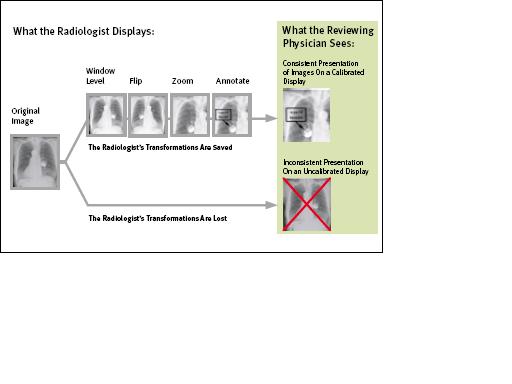Consistent Presentation of Images
Consistent Presentation of Images (CPI) maintains consistent intensity and image transformations between different hardcopy and softcopy devices.
Summary
Consistent Presentation of Images maintains the consistency of presentation for grayscale images and their presentation state information (including user an notations, shutters, flip/rotate, display area, and zoom). It also defines a standard contrast curve, the Grayscale Standard Display Function, against which different types of display and hardcopy output devices can be calibrated. Thus it supports hardcopy, softcopy and mixed environments.
Benefits
<List the key benefits the profile provides (e.g. error reduction, increased throughput) and how they come about (e.g. SWF reduces patient errors due to mistyped demographics at the modality by transfering demographics electronically from the Order Filler). Consider using a bullet list for readability>
Details
<A few paragraphs, if appropriate, providing more details (mostly in user-speak, not tech-speak) on what the profile does and how it works.>
<If the user might be familiar with the mechanisms used by the profile, you can mention them here. E.g. Evidence Documents is based on DICOM Structured Report (SR) Templates.>
<If the user might have an appreciation for the problems addressed in the profile, you can mention them here, but keep it short. E.g. Mapping HL7 Order fields to DICOM Modality Worklist attributes can be inconsistent in the marketplace, so Scheduled Workflow provides vendors with more detailed instructions.>
Systems Affected
The systems included in this profile are hospital-wide and radiology-department image rendering systems such as:
- Review or diagnostic image softcopy display stations (stand-alone or integrated with a HIS, RIS or PACS)
- Image management and archiving systems (PACS)
- Hardcopy image producing systems on various media such as film or paper
- Acquisition modalities
Actors & Transactions:
<Insert an actor-transaction diagram, and or list of Content Definitions>
Specification
Profile Status: Final Text
Documents:
Underlying Standards:
See Also
<The following sections can be left out if there is nothing to point to. This is just to show where such information can go.>
Related Profiles
<List profiles this one depends on, profiles that depend on this one, profiles that are synergistic with this one. Start with the name of the other profile as a link and then explain the relationship.>
- Reporting Workflow [RWF] may use Evidence Documents as inputs to the reporting process.
- Simple Image & Numeric Reports [SINR] may include data copied from Evidence Documents.
- Cross-enterprise Document Sharing for Imaging [XDS-I] can be used to share Evidence Documents between sites over a network.
- Portable Data for Imaging [PDI] can store Evidence Documents on media such as CDs.
- Import Reconciliation Workflow [IRWF] can fix patient ids, etc. of Evidence Documents when importing.
Consumer Information
The Profile FAQ Template answers typical questions about what the Profile does. <Replace the link with a link to the actual FAQ page for the Profile>
The Profile Purchasing Template describes considerations when purchasing equipment to deploy this Profile. <Replace the link with a link to the actual Purchasing page for the Profile>
Implementer Information
The Profile Implementation Template provides additional information about implementing this Profile in software. <Replace the link with a link to the actual Implementation page for the Profile>
Reference Articles
<List References (good and bad) (with link if possible) to Journal Articles that mention IHE's work (and hopefully include some analysis). Go ahead, Google: IHE <Profile Name> abstract or something. You might be surprised. >
This page is based on the Profile Template
